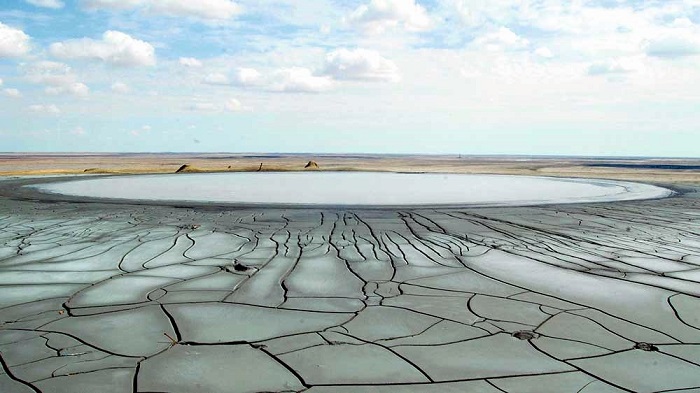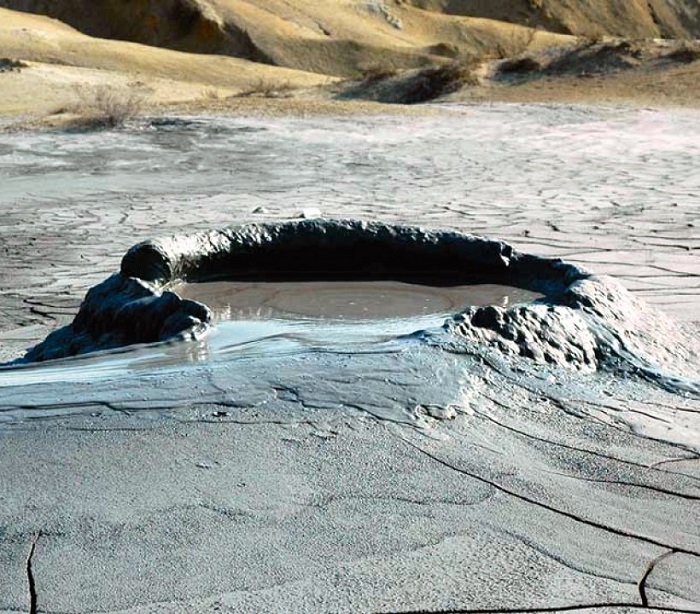Turkmenistan has initiated the process of collecting and analyzing information about ancient geological sites of Turkmen nature – mud volcanoes in the western part of the country. Its classification is necessary for the formation of a nomination dossier for their inclusion in the UNESCO World Heritage List, the Neutral Turkmenistan newspaper reports.
The first expedition, involving representatives of the National Commission of Turkmenistan for UNESCO, biologists, geographers, geologists of the State Corporation “Turkmengeologiya”, the Ministry of Environmental Protection, the Institute of the Caspian Sea, recently explored several mud volcanoes in the Esenguli district of the Balkan province. The team conducted visual inspections, photography, and sample collection of both active and dormant volcanoes.
During the multi-day expedition, the volcanoes were visually inspected, photographed, and soil and clay samples were taken. It should be emphasized that the activity of many volcanoes has been “put on pause”, which does not mean that it has been stopped forever.
 Among the most impressive mud volcanoes are Akpatlavuk and Gekpatlavuk. Akpatlavuk, located near the village of Esenguly, dominates a large hill. Its summit features numerous dome-shaped elevations and griffins, remnants of past eruptions. Deep, winding channels scar the slopes, carved by powerful mud flows. The volcano has also formed a substantial crater lake, fed by gas and mud springs.
Among the most impressive mud volcanoes are Akpatlavuk and Gekpatlavuk. Akpatlavuk, located near the village of Esenguly, dominates a large hill. Its summit features numerous dome-shaped elevations and griffins, remnants of past eruptions. Deep, winding channels scar the slopes, carved by powerful mud flows. The volcano has also formed a substantial crater lake, fed by gas and mud springs.
Gekpatlavuk, rising 70 meters above the sandy plain, is another awe-inspiring sight. Its cone is marked by deep troughs and ravines, formed by flowing streams of gas-laden mud. The volcano’s crater lake is a nearly perfect circle, with mud jets erupting from the center and spreading outwards. During major eruptions, mud can be ejected several meters into the air.
The roots of these geological wonders extend up to eight kilometers deep into the Earth’s crust.
 Following the results of the trip, recommendations were made for further study and protection of volcanic complexes. Several points include the creation of a unified state register of natural heritage sites of Turkmenistan based on modern data, including their exact number, description of parameters and geological location (in a topographic map), ensuring proper maintenance and protection of objects.
Following the results of the trip, recommendations were made for further study and protection of volcanic complexes. Several points include the creation of a unified state register of natural heritage sites of Turkmenistan based on modern data, including their exact number, description of parameters and geological location (in a topographic map), ensuring proper maintenance and protection of objects.
It is also necessary to prepare information on the tectonic and lithological-stratigraphic association of volcanoes with a certain subsurface structure. To record the activity of objects, their “mode of life”, it is necessary to monitor the condition, record the time of the eruption. Modern methods of space and remote sensing can provide such information.
To successfully nominate the mud volcanoes for UNESCO World Heritage status, several key steps are necessary. Modern photography and videography will be essential to showcase the beauty and uniqueness of these formations. The existing atlas of mud volcanoes, compiled in 1952, will need to be updated with current data and information. Insights from Azerbaijan’s experience in studying and preserving mud volcanoes will be valuable.
The mud volcano complexes of the southern Caspian Sea, including those in Turkmenistan, Azerbaijan, and Iran, form a unique geological feature. These formations represent nearly half of the world’s mud volcanoes. There are about twenty mud volcanoes in Turkmenistan that are significant for science.
According to scientists, mud volcanoes probably formed as a result of the reduction of the Tethys Sea in Turkmenistan, which began 10-12 million years ago.
The Cheleken Peninsula is characterized by numerous tectonic cracks, suggesting a history of powerful mud volcanic eruptions. The inactive Aladag volcano is the largest in the region, with ejected rocks found up to 1.5 kilometers from its presumed vent.
It’s important to distinguish between mud volcanoes and magmatic volcanoes. While mud volcanoes are driven by the expulsion of mud and gas, magmatic volcanoes erupt molten rock (magma). In Turkmenistan, ancient magmatic volcanoes can be found in areas like Tuarkyr, near the Big Balkhan mountains, the Krasnovodsk Peninsula, and Badkhyz. These volcanoes, formed approximately 50-55 million years ago, never erupted on the surface, solidifying beneath the ancient Tethys Sea.

